Benefits of Disposable Headphone & Headset Covers
Posted by Barry Leeper on 3rd Dec 2021
Why are Disposable Covers Used on Headphones and Headsets?
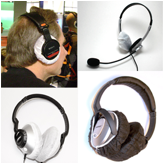 Disposable Covers Should be Used on Shared Headphone
Disposable Covers Should be Used on Shared Headphone
Many people don't really realize that each time headphones and headsets are shared among many different users, it increases the user’s health risks. Wearing headphone covers can definitely lower those risks and help to protect each of the users. The exposure and direct skin contact with headphones could possibly pass on bacterial infections and head lice, or spread viruses and germs to those who share the headphones and headsets.
Shared headphones could inadvertently cause the spread of influenza, the common cold and Covid-19. Hospitals that use headphones for patients, need to take extra steps to also protect patients from spreading MRSA and other contagious diseases. Headphones and headsets that are repeatedly shared without protective covers, could actually put individual headphone users at risk and it could lead to illnesses that can be avoided. Disposable headphone covers allow the audio to pass through just fine, and they cover the soft foam or leatherette material that might otherwise come into direct contact with each user's skin. Shared headphones and headsets should be cleaned regularly using alcohol, an antibacterial cleanser or disposable cleaning wipes. Check to make sure that your cleaning solutions are safe for use on plastics, and you will also preserve the headphones for long-term use.
How do Disposable Headphone Covers Provide Protection for Shared Headphone Users?
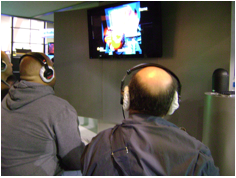 Most people don’t realize that they are at risk when using shared headphones. If your skin and hair came into direct contact with headphone surfaces from headsets that were worn by many other users, you may have unknowingly exposed yourself to a host of health threats. Keep in mind that steps can be taken to prevent skin and hair contact with the parts of the headphones (or headsets) that can potentially spread disease, infection and viruses to each of the headphone users. Steps should be taken to clean the headphone headbands and headset earpieces with an antibacterial cleaner or alcohol wipes in order reduce the risks associated with shared headphones and headsets.
Most people don’t realize that they are at risk when using shared headphones. If your skin and hair came into direct contact with headphone surfaces from headsets that were worn by many other users, you may have unknowingly exposed yourself to a host of health threats. Keep in mind that steps can be taken to prevent skin and hair contact with the parts of the headphones (or headsets) that can potentially spread disease, infection and viruses to each of the headphone users. Steps should be taken to clean the headphone headbands and headset earpieces with an antibacterial cleaner or alcohol wipes in order reduce the risks associated with shared headphones and headsets.
Why Are so Many Headphones and Headsets Shared Among Multiple Users?
 Good quality headphones can be quite expensive, so many businesses, including medical imaging centers, dental offices, court rooms, translation services, drive through restaurants, educational facilities, correctional facilities and call centers have all chosen to offer their employees and clients the use of shared headphones and headsets, knowing that it is less expensive to recycle the headphones rather than provide new headphones for each user. In the past, people did not worry so much about the germs that might be lurking on their headphones, however the recent Covid-19 pandemic has certainly made people more aware of the potential risks from bacteria, germs and viruses.
Good quality headphones can be quite expensive, so many businesses, including medical imaging centers, dental offices, court rooms, translation services, drive through restaurants, educational facilities, correctional facilities and call centers have all chosen to offer their employees and clients the use of shared headphones and headsets, knowing that it is less expensive to recycle the headphones rather than provide new headphones for each user. In the past, people did not worry so much about the germs that might be lurking on their headphones, however the recent Covid-19 pandemic has certainly made people more aware of the potential risks from bacteria, germs and viruses.
How did Covid-19 Change the Use of Headphone Covers?
Although Covid-19 is microscopic in size and invisible to the naked eye, it has certainly increased public awareness of the increased risks associated with the use of shared headphones. Some companies have preferred to offer single-use, disposable headphones. Others found the replacement foam Earpads provided a degree of cleanliness that was acceptable for short-term headphone use. The initial strain of Covid-19 did not live long on surfaces, however the Covid-19 strains mutated, making them far more contagious as they posed an even higher risk. As the Covid-19 Delta and Omicron strains emerged, they found that those strains posed a higher risk because they also could remain alive on surfaces longer and spread much faster. As a result, the disposable covers for headphones and headsets have also evolved into essential tools in terms of preventing the spread of Covid-19.
The impact of the Covid-19 pandemic triggered the need for added protection, as businesses (including hospitals, correctional facilities, courthouses, fast-food restaurants and food service providers) began ordering large quantities of disposable covers for their headphones, headsets and microphones. Many employers ordered disposable covers to protect workers from catching and spreading the Coronavirus as others acted to limit employee absenteeism and the legal liability associated with the germs spread from shared headphones, headsets and microphones.
How Can Call Centers Benefit from Disposable Headphone Covers?
 Many Call Centers provide individual headsets for each of their employees. Some employees are required to pay for their own headset, and others have only a limited quantity of headsets for employee use, and as a result, the employees must share a limited number of available headsets. Many customer service representatives and call center personnel routinely use shared headsets with those that work a different shift. Some have elected to replace the foam Earpads on a regular basis, and others will put sanitary headset covers onto each of the headsets to provide their staff with protection. Most Call Centers had been offering their employees the disposable headset covers to help reduce employee absenteeism that might be triggered by the flu or the common cold. As the Covid-19 pandemic emerged, many of the call centers that used to only order covers for the earpieces, also began ordering our microphone covers to protect workers from the moisture laden spittle that might otherwise collect on the headset microphones through normal speech.
Many Call Centers provide individual headsets for each of their employees. Some employees are required to pay for their own headset, and others have only a limited quantity of headsets for employee use, and as a result, the employees must share a limited number of available headsets. Many customer service representatives and call center personnel routinely use shared headsets with those that work a different shift. Some have elected to replace the foam Earpads on a regular basis, and others will put sanitary headset covers onto each of the headsets to provide their staff with protection. Most Call Centers had been offering their employees the disposable headset covers to help reduce employee absenteeism that might be triggered by the flu or the common cold. As the Covid-19 pandemic emerged, many of the call centers that used to only order covers for the earpieces, also began ordering our microphone covers to protect workers from the moisture laden spittle that might otherwise collect on the headset microphones through normal speech.
What are the Most Common Uses of Shared Headphones and Headsets?

In the past, record stores would have a common kiosk that allowed multiple users to listen to vinyl records, CD’s and DVD’s. Consumers at the record stores could then listen to the audio and make a decision before buying a new record, disc or video. Theaters would provide headphones for patrons who were hard of hearing or had hearing limitations and the users would turn in their headphone after the show. It is not always clear if those headphones were cleaned and disinfected, or if they just quickly recycled for the next performance. Had they placed headphone covers on the headphones, or made them available to each of the users, it would have given users peace of mind, and helped to prevent the spread of germs from one user to another.
 Museum’s often provided headphones to visitors, so that their patrons could learn background information about the museum exhibits. It was not uncommon for people attending a trade show or business presentation to be gathered into a trade show booth so they could put on headphones before watching a business presentation. The headphone users would certainly feel safer knowing that the headphones have a sanitary barrier to protect them from germs, bacteria and viruses. It takes only a few seconds to discard the old covers and place new ones onto the headphone. It would be ideal if each user were encouraged to remove their used headphone cover after each use, and dispose of the covers afterwards. The covers are made from a type of material that is biodegradable, so our headphone covers are not harmful to the environment. They are also latex free, so those with sensitivities to latex can be protected, without worrying about any latex or harsh chemicals.
Museum’s often provided headphones to visitors, so that their patrons could learn background information about the museum exhibits. It was not uncommon for people attending a trade show or business presentation to be gathered into a trade show booth so they could put on headphones before watching a business presentation. The headphone users would certainly feel safer knowing that the headphones have a sanitary barrier to protect them from germs, bacteria and viruses. It takes only a few seconds to discard the old covers and place new ones onto the headphone. It would be ideal if each user were encouraged to remove their used headphone cover after each use, and dispose of the covers afterwards. The covers are made from a type of material that is biodegradable, so our headphone covers are not harmful to the environment. They are also latex free, so those with sensitivities to latex can be protected, without worrying about any latex or harsh chemicals.
 Many schools and libraries have computer labs where headphones are frequently shared among each of the computer users. Surprisingly, most of those shared headphones did not have access to headset covers. They certainly could have benefited from the added protection and safety that could have been there, had someone procured some sanitary disposable headphone covers for the computer users. Those schools universities and call centers that have proactively provided headset covers for their patrons and employees, are minimizing their risk at the same time that they are helping to prevent the users from becoming ill as a result of using shared headphones.
Many schools and libraries have computer labs where headphones are frequently shared among each of the computer users. Surprisingly, most of those shared headphones did not have access to headset covers. They certainly could have benefited from the added protection and safety that could have been there, had someone procured some sanitary disposable headphone covers for the computer users. Those schools universities and call centers that have proactively provided headset covers for their patrons and employees, are minimizing their risk at the same time that they are helping to prevent the users from becoming ill as a result of using shared headphones.
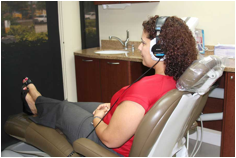
Due to the repetitive use of shared Headphones and headsets it would be best to protect each of the users from spreading colds, influenza, bacteria, Covid-19 and various skin conditions. If the headphones and headsets are properly covered with disposable headphone covers, the potential health issues will be minimized. Individuals with skin sensitivities will be much better off if the headphones they are wearing have been covered, protecting their sensitive skin from a possible flare up that might otherwise occur if their skin was to come into direct contact with the headphone earpieces. The headphone covers are totally hypoallergenic and contain absolutely no latex, so they are safe for use by those who typically suffer due to skin sensitivities.
The use of safe, protective personal protection using disposable materials has risen dramatically since new viruses were discovered, including SARS, Swine Flu, Bird Flu, Zeka, Ebola and the Coronavirus known as Covid-19.
Steps are being taken to protect each user from Covid-19, influenza and the common cold at institutions that commonly share headphones and headsets among many different users, including the following:
- Schools, Universities
- Job Training Centers
- Computer Labs
- Pilot Simulators
- Libraries
- Museums
- Shows and Theaters
- Business Meetings
- Employee Training Programs
- New Employee Screening
- Translation Use
- Visitor Tours, Plant Tours and Tour Guides
- Judicial Hearings, Depositions and Various Legal Proceedings
- Court Rooms
- Sales Presentations and Trade shows
- Call Centers
- Drive-Through Restaurants
- Correctional facilities
- Recording Studios
- Broadcast and Stage Personnel
- MRI Scanners and Patient Imaging Facilities
- Air Traffic Control
- Pilots and Ground Crew Personnel
- Dental and Orthodontia facilities
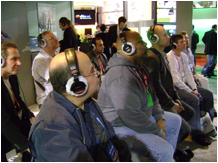
The individuals shown in the picture here, attended a trade-show and they were provided with headphones that were fitted with disposable headphone covers. This provided each of the headphone users with protection from microscopic material that might have been unknowingly shed from each of the prior users. Most everyone would feel uncomfortable knowing how easily lice can easily be transferred from one headphone user to another. That is why groups of individuals should not be sharing headphones without any protection. Cologne, hair sprays, moisturizing lotions and hair gel can be easily transferred from one user to another as well, so it is also beneficial to clean the headbands with an antibacterial cleaner that is hypoallergenic.
Would you feel comfortable wearing a shared headphone?
Some individuals are extremely sensitive to perfumes, hair gels, hair sprays, natural skin oils and microscopic size bacteria and viruses that can adhere to the headphone surfaces. As a result, users might potentially have an adverse reaction if the headphones or headsets are shared without effective cleaning, protection or sanitization. Suppose that prior headphone users had eczema, psoriasis, herpes, ringworm, MRSA, head lice, poison ivy, Covid-19 or might have been HIV Positive?
 Most headphones and headsets have open cell foam material within the earpieces and that foam usually rests directly against each user’s ears. The sponge foam in those earpieces is an ideal place for head lice and bacteria to collect, and nobody would realize those harmful organisms are present, just waiting for a new host. The warm, moist conditions within the small foam cells within the earpieces are favorable for further growth and the spread of those germs and organisms. Furthermore, the sponge foam cushions inside the headphone earpieces aren’t easily cleaned with alcohol wipes.
Most headphones and headsets have open cell foam material within the earpieces and that foam usually rests directly against each user’s ears. The sponge foam in those earpieces is an ideal place for head lice and bacteria to collect, and nobody would realize those harmful organisms are present, just waiting for a new host. The warm, moist conditions within the small foam cells within the earpieces are favorable for further growth and the spread of those germs and organisms. Furthermore, the sponge foam cushions inside the headphone earpieces aren’t easily cleaned with alcohol wipes.
What are the Disposable Headphone Covers and Headset Covers Made of?
Most headphone covers are made from a “spun-bond polypropylene”, a synthetic fabric material. This type of non-woven fabric is commonly used to make disposable surgical garb, shoe protectors, wet wipes, alcohol wipes and PPE products such as face masks. Our disposable covers stretch completely around the outer edges of the headphone and headset earpieces and the non-woven polypropylene is thin enough that it will let sound pass through while providing a protective barrier against the user’s skin, hair and ears. There are several different headphone covers sizes and their use will not appreciably change any noticed sound characteristics. The disposable headphone covers offered by Scan Sound have helped to reduce the risks associated with exposure to harmful residues, contagions, bacteria, influenza, viruses, the common cold, MRSA, HIV and Covid-19 by limiting skin contact. If the headphone covers are contaminated with harmful germs and the covers are removed and disposed of, then they are helping to dramatically reduce individuals from coming into contact with the germs, bacteria and viruses that otherwise would be present on the shared headphones.
SKU# FHCB Fabric Headphone Covers (Black)
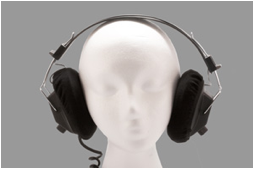
Scan Sound also offers reusable cotton fabric headphone covers that can be washed and repeatedly used many times. All our stretchable covers are latex free and hypoallergenic. The cotton fabric headphone covers help provide separation between the user's ears and the headphone cushions. As a result there is very little in the way of heat transfer from the headphone earpieces. The cotton fabric can also absorb perspiration to ultimately make it more comfortable for users to wear headsets and headphones for long periods. This makes them a great option for athletes as well as those who sit on the sidelines, wearing headphones for long periods.
These headphone covers can be routinely washed in a regular washing machine and then returned back to use on the user's own headphones.
Why Use Disposable Headphone Covers and Headset Covers?
 Shared headphones and headsets using the disposable headphone covers can help prevent the spread of viruses, including the common cold, influenza and Covid-19. Prior to the 2020 Coronavirus outbreak, many well-known hospitals routinely ordered headphone covers to provide patient protection and help to contain the spread of infectious diseases, including MRSA, which can be easily spread by contact within hospitals. During the peak periods of the Covid-19 outbreak, the demand for the headphone covers increased dramatically as schools, hospitals, clinics and imaging facilities worldwide expanded their use to protect the public, especially those who were immune compromised. Scan Sound was proud to step up its operations and continually provide our disposable covers worldwide in order to meet the demand for PPE materials used in the fight against the spread of Covid-19.
Shared headphones and headsets using the disposable headphone covers can help prevent the spread of viruses, including the common cold, influenza and Covid-19. Prior to the 2020 Coronavirus outbreak, many well-known hospitals routinely ordered headphone covers to provide patient protection and help to contain the spread of infectious diseases, including MRSA, which can be easily spread by contact within hospitals. During the peak periods of the Covid-19 outbreak, the demand for the headphone covers increased dramatically as schools, hospitals, clinics and imaging facilities worldwide expanded their use to protect the public, especially those who were immune compromised. Scan Sound was proud to step up its operations and continually provide our disposable covers worldwide in order to meet the demand for PPE materials used in the fight against the spread of Covid-19.
How to Use the Headphone and Headset Covers
The disposable headphone covers can be easily installed by stretching the elasticized opening around the outer edges of the headphone earpieces. The stretchable material comes to rest over the earpieces and is held in place during use by the stretchable opening. The headphone and headset covers can be easily removed after use by pulling them off of the headphone. The headphone covers are degradable, and made from environmentally friendly non-woven polypropylene material.
Some individuals using the same headset repeatedly over several days, can keep one headset cover in place until they are ready to pass the headset on to a new user. Each user should dispose of their own used headset covers prior to passing the headset on to another user. They should also wash their hands after removing and disposing of the headphone covers to ensure there are no residual germs on their hands.
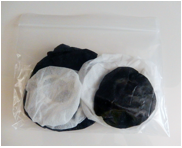 Some schools have routinely provided a pair of headset covers to students along with a Zip-style plastic bag (to store the covers while not in use). The students wrote their name on the outside of the cover to identify the user and that also helped them to recognize which side faced outward. The students repeatedly used and re-used their own headset covers each time they went to the school’s computer lab. This enabled many users to utilize a single pair of headset covers for their own protection and they helped save money for the school system by re-using their own set of headset covers when they were needed. Similarly some gaming headphone users also placed their name on each of their own covers and repeatedly reused their own headset covers when playing computer games.
Some schools have routinely provided a pair of headset covers to students along with a Zip-style plastic bag (to store the covers while not in use). The students wrote their name on the outside of the cover to identify the user and that also helped them to recognize which side faced outward. The students repeatedly used and re-used their own headset covers each time they went to the school’s computer lab. This enabled many users to utilize a single pair of headset covers for their own protection and they helped save money for the school system by re-using their own set of headset covers when they were needed. Similarly some gaming headphone users also placed their name on each of their own covers and repeatedly reused their own headset covers when playing computer games.
How to Choose the Appropriate Headphone Covers
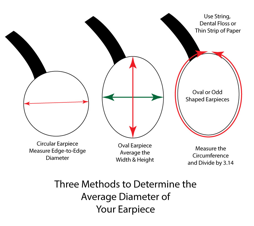 We recommend that you measure the headphone earpiece diameter before choosing the headphone cover that will fit your earpiece. The diameter can be used as a guide to know what size disposable headphone cover or disposable headset cover is appropriate for your particular headphones. As you can see here, there are three methods that you can use to measure your headphone earpiece diameter.
We recommend that you measure the headphone earpiece diameter before choosing the headphone cover that will fit your earpiece. The diameter can be used as a guide to know what size disposable headphone cover or disposable headset cover is appropriate for your particular headphones. As you can see here, there are three methods that you can use to measure your headphone earpiece diameter.
Using the information shown below, determine which size headphone cover is appropriate for your headphone or headset diameter:
- If the earpiece is circular, you can measure directly across the earpiece to get the diameter.
- If your earpiece is oval shaped, you will need to average the width and height to get the diameter.
- If you measure the circumference (all the way around) remember to divide that by PI (3.14) to get the resulting diameter.
| Diameter in Inches | Diameter in Millimeters | Size to Order | SKU# |
| 1 to 2 ½ inches | 25 to 63.5mm | Small Size | SS-3-100 White |
| 2 to 3 ½ inches | 50.8 to 89mm | Medium Size | SS-4-100 White SS-4B-100 Black |
| 3 to 5 inches | 76 to 127mm | Large Size | SS-2-100 White |
| 4 to 7 inches | 102 to 178mm | Extra Large Size | CH-0150 |
| 3 to 4 ¾ inches | 76 to 121mm | Fabric Headphone Covers | FHCB |
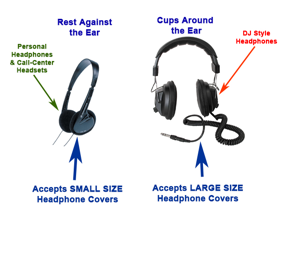
What Size Fits onto Most Call-Center-Style Headset Earpieces
Our Small Size headphone covers usually fit onto headphones and headsets earpieces that are typically less than 2.5 inches in diameter. Those earpieces usually rest against the ear. The Small Size headphone covers are available in Black or White and they are bagged in quantities of 100 covers per bag for $17.00. We offer a discount of $15 per bag when buying 10 bags at a time, and the $20 saving helps to offset the cost of shipping.
The small size headphone covers are also available in a dispenser box containing 1,000 disposable headphone covers. The dispenser box has an oval perforated opening, making it possible to dispense individual headphone covers, as shown in the photo below.
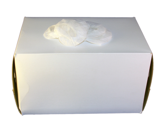
SKU# SS-3-1000 • Dispenser Box with 1000 Small Size Disposable Headphone Covers, White
Here are our SKU numbers:
| Small Size White Covers | 100 Covers per bag | SS-3-100 or TMC-100 |
| Small Size Black Covers | 100 Covers per bag | SS-3B-100 |
| Small Size Red Covers | 100 Covers per bag | SS-3R-100 |
| Small Size White Covers | 1000 Covers in Dispenser Box | SS-3-1000 or TMC-1000 |
| Small Size Black Covers | 1000 Covers in Dispenser Box | SS-3B-1000 |
| Medium Size White Covers | 100 Covers per bag | SS-4-100 |
| Medium Size Black Covers | 100 Covers per bag | SS-4B-100 |
| Large Size White Covers | 100 Covers per bag | SS-2-100 |
| Large Size Black Covers | 100 Covers per bag | SS-2B-100 |
| Extra-Large Size White Covers | 100 Covers per bag | CH-0150 |
If your headphone earpieces completely surround your ears, you will most likely want to order the Large Size headphone covers. They are available in Black or White, with 100 pieces per bag.
- The Large Size White Headphone Covers are SKU# SS-2-100
- The Large Size Black Headphone Covers are SKU# SS-2B-100
- Some Gaming Headphones and MRI Scanner Headphones have very large earpieces that range in size between 4 inches and 7 inches in diameter, and they might require our Extra-Large Size Headphone Covers, SKU# CH-0150.
Are Disposable Covers Available for Telephones?
Our small size headphone covers were made to also fit onto telephone handsets as shown above. These small size disposable covers are called “TeleMask” covers. They are available in bags of 25,100 and a box of 1,000. The SKU numbers and URL links are shown in the table below:
|
TeleMask Small Size White Covers |
25 Covers per bag | TMC-25 |
| TeleMask
Small Size White Covers |
100 Covers per bag | TMC-100 Same as SKU# SS-3-100 |
| TeleMask
Small Size White Covers |
1000 Covers in Dispenser Box | TMC-1000 Same as SKU# SS-3-1000 |
TeleMask Stretchable Covers for Telephone Handsets
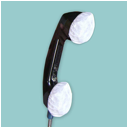 These covers will only fit onto the older style handset telephones. Most modern desk phones have a different design, and unfortunately the TeleMask covers are not able to hold onto the earpiece or mouthpiece.
These covers will only fit onto the older style handset telephones. Most modern desk phones have a different design, and unfortunately the TeleMask covers are not able to hold onto the earpiece or mouthpiece.

